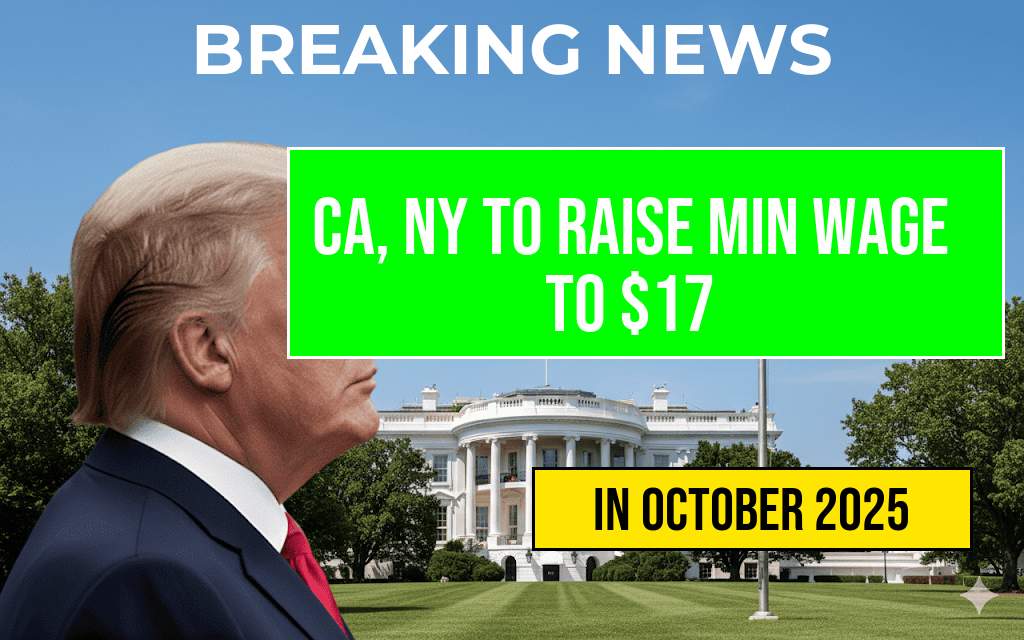California and New York are set to implement significant increases to their minimum wage rates, with both states planning to raise the minimum to $17 an hour over the next two years. The announcements, made by state officials on Tuesday, mark a notable shift in wage policy aimed at addressing the rising cost of living and economic disparities. California’s plan will see the minimum wage increase gradually over the next 24 months, while New York’s schedule involves staged increments across different regions, reflecting the varying economic landscapes within the state. These moves are part of broader efforts to lift low-income workers and reduce income inequality, though they also raise questions about potential impacts on employment and business competitiveness.
Details of the Wage Increases
California’s Stepwise Approach
The California Department of Industrial Relations announced that the state’s minimum wage will rise from $15.50 to $17 an hour by January 1, 2025. This increase is part of the state’s ongoing effort to reach a target minimum wage of $18 an hour for larger employers by 2026, aligning with the state’s broader economic equity goals. The phased implementation allows businesses to adjust gradually, minimizing disruptions while ensuring workers benefit from increased earnings. The plan affects businesses with 26 or more employees, while smaller employers will see a similar increase scheduled for 2026.
New York’s Regional Approach
New York’s wage hike plan varies across regions, with the state Department of Labor outlining different timelines based on local economic conditions. In New York City, the minimum wage will increase from $15 an hour to $17 by the end of 2024. Upstate regions and other parts of the state will follow a similar phased schedule, with the goal of reaching the $17 threshold by mid-2025. The regional approach acknowledges the diverse cost of living across the state, aiming to balance economic growth with affordability.
Economic and Political Context
Political Commitments and Legislation
The wage increases are rooted in longstanding legislative efforts and political commitments. California’s governor, Gavin Newsom, has emphasized the importance of fair wages as part of his economic agenda, citing the need to support essential workers and reduce poverty. Similarly, New York Governor Kathy Hochul has championed regional wage policies, arguing they are necessary to sustain economic vitality in different parts of the state. Both leaders have faced pressure from labor unions and advocacy groups calling for higher minimum wages to combat income inequality.
Industry Impact and Business Response
While proponents argue that higher wages will boost consumer spending and improve worker productivity, some industry representatives express concern about increased labor costs. Small businesses, in particular, worry about the financial strain of higher wages, especially in sectors such as hospitality and retail where profit margins are tight. Industry groups are urging policymakers to consider support programs or phased implementations to mitigate potential job losses or business closures.
Potential Effects on Workers and the Economy
| Aspect | Expected Impact |
|---|---|
| Worker Earnings | Significant boost for low-income workers, reducing reliance on social safety nets |
| Cost of Living | Potential alleviation of affordability issues in urban centers like Los Angeles and New York City |
| Employment Levels | Possible short-term stabilization; long-term effects remain subject to economic conditions |
| Business Operations | Increased operational costs; may lead to adjustments in staffing or prices |
Broader Economic Implications
Analysts highlight that raising the minimum wage to $17 an hour could influence broader economic dynamics, including inflationary pressures and consumer spending patterns. While some studies suggest that moderate wage hikes do not significantly impact employment, others warn of potential job reductions in vulnerable sectors. Policymakers are monitoring these developments closely, with many emphasizing that the benefits of higher wages—such as reduced income inequality and improved quality of life—justify the investment.
Public Reception and Future Outlook
Public opinion on minimum wage increases remains polarized. Labor advocates celebrate the moves as overdue steps toward economic justice, while some business groups caution about unintended economic consequences. The upcoming months will reveal how these wage adjustments influence employment rates, business health, and living standards across California and New York.
As both states push forward with these wage policies, they are also exploring complementary measures such as expanded worker protections and affordable housing initiatives. The combined efforts aim to create a more equitable economic environment that can sustain growth without placing undue burdens on employers or consumers.
For more information on minimum wage policies and their economic implications, readers can visit Wikipedia’s overview of minimum wage and consult recent analyses from Forbes.
Frequently Asked Questions
What is the new minimum wage being implemented in California and New York?
The new minimum wage in both California and New York will be raised to seventeen dollars an hour.
When will the minimum wage increase take effect?
The specific implementation date may vary by region, but both states are planning to raise the minimum wage to $17 an hour within the upcoming months or years as part of their respective wage policies.
What are the reasons behind the wage increase in California and New York?
The wage hike aims to improve living standards, address cost of living increases, and promote economic growth by ensuring workers earn a fairer minimum wage.
Who will be affected by the minimum wage increase?
The increase will impact low-wage workers across various sectors, including retail, hospitality, and service industries, ensuring they receive a living wage.
Are there any exceptions or phased implementations for the wage increase?
Some regions or businesses may have phased wage increases or exemptions based on size or industry. It is advisable to check local regulations for specific details.






